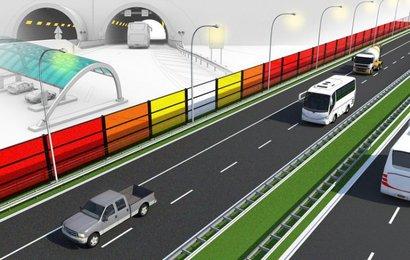Highway Barriers Block Noise, Generate Solar Energy
July 7, 2015

Noise barriers are often installed next to highways to block the sound of the traffic from nearby residents and businesses. Now thanks to researchers in The Netherlands, sound barriers installed at the A2 highway in the southern part of the country have a two-fold purpose: to block sound and also to harvest solar energy.
The barriers were erected in mid-June near the region of Den Bosch as a test to assess the economic and technical feasibility of using a new type of solar panels -- developed by researcher Michael Debije from Eindhoven University of Technology, or TU/e.

Indeed, The Netherlands has been doing a lot of experimentation with unique ways to harvest solar energy. We've told you how the first solar roadway was installed in Krommenie, Holland. The Dutch also developed a path modeled after Vincent van Gogh's "Starry Night" painting that uses solar-energy-harvesting coating to harvest energy from the sun.
The technology used in the Den Bosch project are translucent, colored panels called luminescent solar concentrators (LSCs). They harvest energy from sunlight and guide it to the side of the panels, where it falls in concentrated form on traditional solar cells.
MORE FROM DESIGN NEWS: Solar Shingles Poised As Next Renewable Trend
Each of the two noise barriers is 5 meters wide and 4.5 meters high. In addition to the LSC panels, the barriers also include semi-transparent panels holding classical solar cells for comparison purposes. Initial results from Debije's research show that 1 km of energy-generating noise barriers can produce enough electricity to power 50 homes.
The LSCs have a visually pleasing aspect to them, which makes them suitable for urban projects like sound barriers and other applications where aesthetics come into play, Debije -- a researcher in the Department of Chemical Engineering and Chemistry -- said in a press release on the TU/e website.
"Thanks to their many colors the LSC are visually very attractive, which makes them ideal for use in many different situations in the built environment," he said. "Further benefits are that the principle used is low cost; they can be produced in any desired, regular color; [they are] robust; and the LSCs will even work when the sky is cloudy. That means it offers tremendous potential."
Debije has published a paper about his work in an article in the journal Nature.
MORE FROM DESIGN NEWS: Holland Tests World's First Solar Roadway
The test will run for one year in which Debije and other researchers will assess the feasibility of generating electricity using solar cells integrated in noise barriers, the first test of its kind in The Netherlands.
In addition to providing a better understanding of how much electricity these semi-transparent screens can generate under different conditions, vandal-resistance and the maintenance requirements of the barriers also are being tested in the project.
Elizabeth Montalbano is a freelance writer who has written about technology and culture for more than 15 years. She has lived and worked as a professional journalist in Phoenix, San Francisco, and New York City. In her free time she enjoys surfing, traveling, music, yoga, and cooking. She currently resides in a village on the southwest coast of Portugal.
About the Author(s)
You May Also Like



